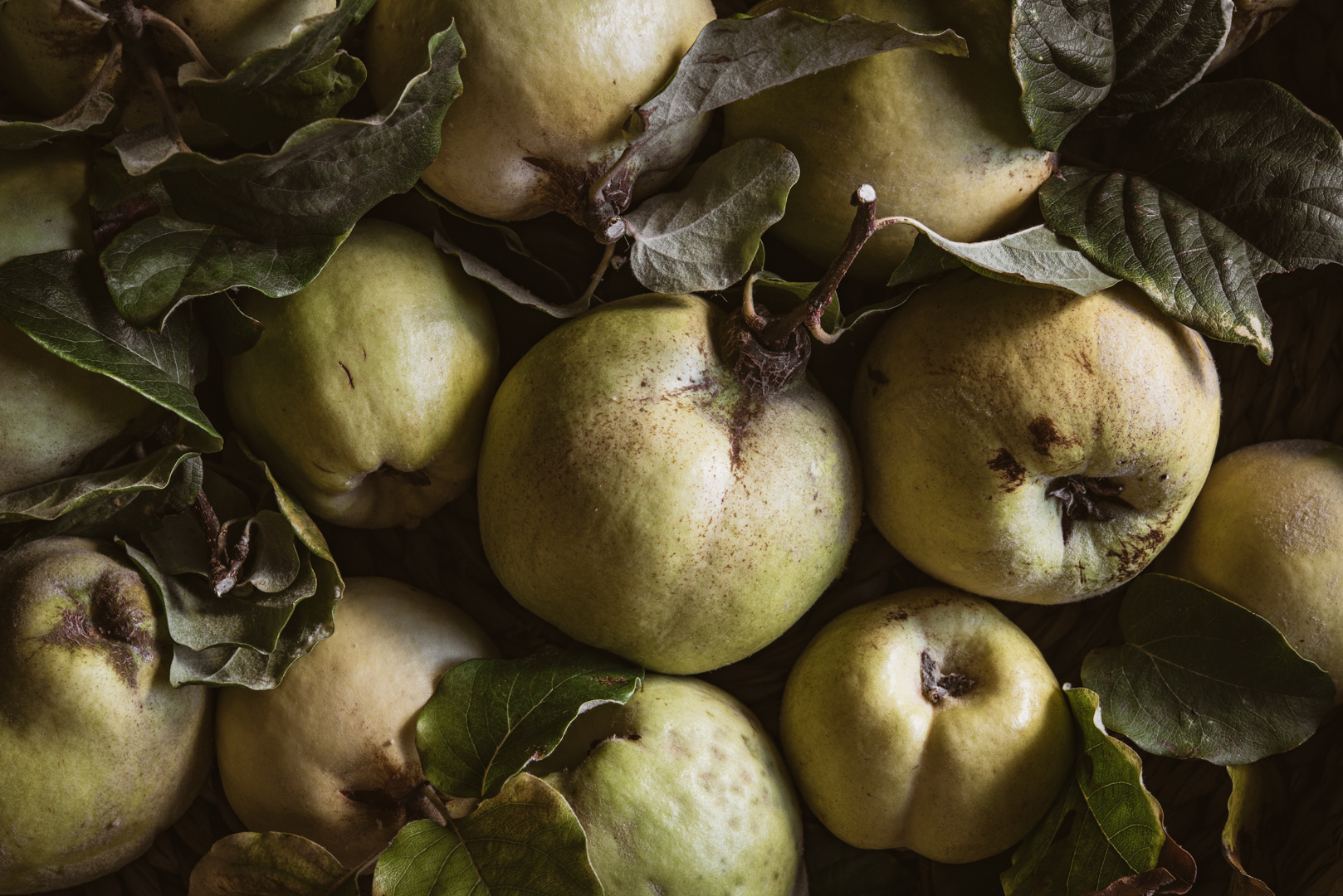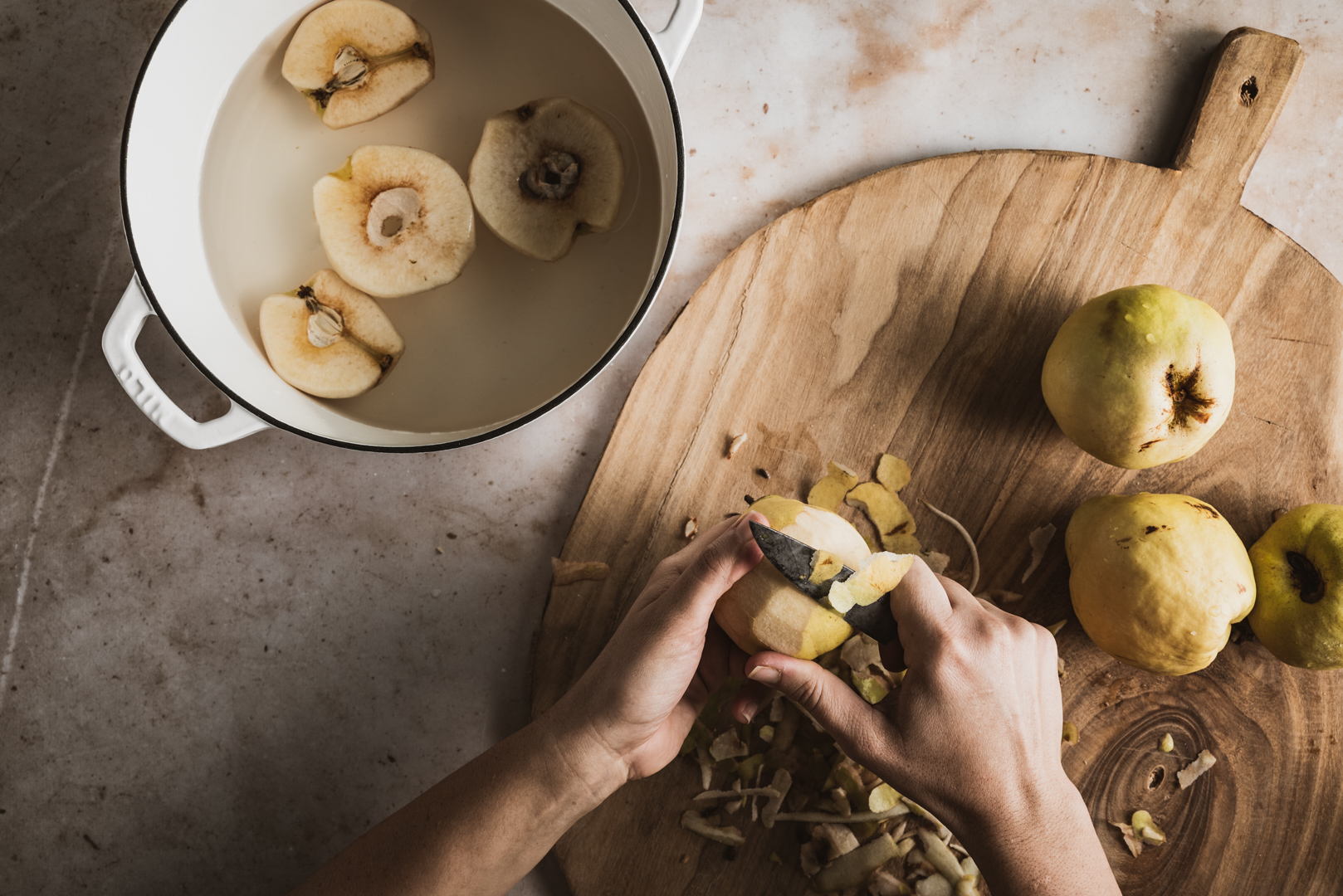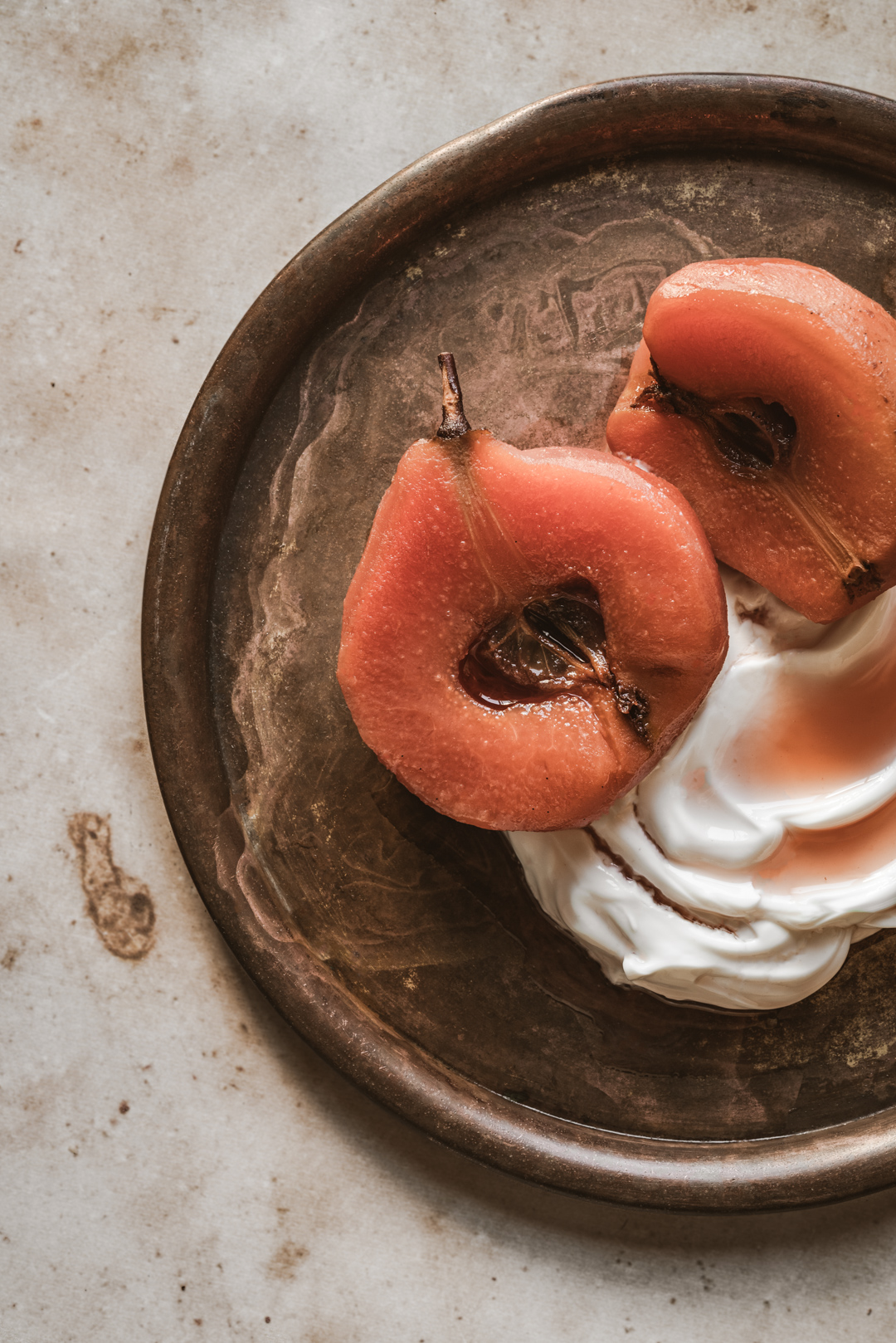Quince – a somewhat uncomely fruit, with its irregular shape and form. It may not be love at first sight, but with proper preparation this ancient fruit becomes the most glorious experience. This honey poached quince recipe is the ideal way to magnify the hidden glory of this ancient fruit.
A QUINCE ORIGIN STORY:
My first experience with quince was in Greece. On one of our family evening strolls, my father-in-law spotted a fruit tree that I was not familiar with. He decided to grab one of the unusual looking fruits and seemed very excited about his discovery. “Kυδώνι: key-thOH-nee” he said to me, teaching me the fruit’s name in Greek before he revealed that it was quince. And while I had heard of quince back in America, I had never had the opportunity to taste it.
My father-in-law began to recollect his memories of eating quince as a child in Northern Greece. He explained that he and his siblings would eat them raw off the tree, a very uncommon practice. Because they were very poor, they did not have the money to buy honey or sugar to prepare poached quince in the traditional Greek manner. We walked home with the lone fruit for my father-in-law to enjoy & reminisce. While for me, that quince would only be a memory and an insight into my father-in-law’s childhood in Greece.


The other day here in Northern California I had my own “κυδώνι” experience. Upon walking through a park that I rarely frequent, I happened to notice a quince tree. Abandoned and forgotten in between two fences, the sight of this quince tree left me overjoyed! We harvested every last fruit and walked home with over a 10 pound bounty!
I washed off the cloak of dusty fuzz that covered each fruit to reveal their beautiful golden hue and their absolutely divine aroma. The smell alone was enough to leave me in awe. Our entire home became filled with their utterly unique fragrance. Coming upon this tree was such a blessing because quince are not commonly found at grocery stores or even farmers markets here. I couldn’t wait for to start poaching our quince bounty with honey.

HONEY & QUINCE: THE PAIRING OF ANTIQUITY
Our bounty was plentiful enough that we would be able to use the quince in several different ways. The first way I chose to prepare them was by making this simple and beautiful honey poached quince. Before the advent of modern processing that made the way for refined sugars, honey was the sweetener of the ancient Mediterranean world. Honey is the traditional sweetener used in ancient Greek cooking and it is also the primary sweetener we use choose to use in our modern kitchen.
To make honey poached quince, the fruit takes a long simmer in a bath of water, honey, lemon and vanilla. When the quince emerge from their sweet soak, they have turned the most amazing rosy hue. Their once hard and tough texture has turned tender with an intriguing flavor that no other fruit can quite compare to. Thinly sliced and eaten over thick Greek yogurt or turned into a tarte tatin, honey poached quince are something we will look forward to every fall, as long as we can get our hands on some quince.

HONEY POACHED QUINCE
Notes
adapted from David Lebovitz
Ingredients
- 6 large or 8 medium quince
- 6 cups water
- 1 1/2 cups honey
- juice of 1 lemon
- 1 vanilla bean, split in half lengthwise
Instructions
- Add water, honey, lemon juice and vanilla bean to a medium stock pot set over medium heat, stir contents until honey is fully dissolved
- Remove the skin with a peeler, halve or quarter your fruits (leaving the seeds) and then slip each prepared section into the poaching liquid as you go to keep the quince from browning
- Once all of the quince sections are in the poaching liquid and the liquid is simmering, turn the heat to low & set a round of parchment paper to act as a lid on the surface of the quince.
- Gently simmer the quince rotating them occasionally, until they are rosy and can be easily pierced with a knife (this usually takes anywhere from 1.5-3 hours depending on the size & ripeness of your quince fruits)
- Remove from heat and let them cool to room temperature - once cooled, store quince in their poaching liquid in a covered container in the refrigerator













Hello, quince and pomegranate are always my favorites in winter. Just a little tip for your quince recipes. Add the quince pits to the poaching liquid to have a brighter and near red color. You even can add the entire core, so you can discard them easily when your poached quinces are ready. Thank you for all the recipes with quince.
I have heard that adding the pits can do that, thank you so much for the tips! <3
Beautiful recipe, Bella! The honey adds a nice complex sweetness to the quince and makes an amazing poaching liquid. I can’t wait to add it to sparkling water! It also makes your home smell heavenly. Great to make on a cold fall day!
Thank you so much Kara! I am so very honored that you loved my recipe :) Honey really does make such a beautiful accompaniment to quince and the poaching liquid will most certainly be delicious with sparkling water!
This is such a beautiful recipe! My house smelled heavenly as the quince cooked in honey, vanilla and lemon. I also really like that it is made without sugar and honey alone. I have been loving reducing the poaching liquid and drizzling it like syrup over the quince on my morning oats or yogurt bowls. It is also the most gorgeous color- absolutely delicious.
Thank you so much for sharing your experience of my recipe Danielle! I am very happy to read that you enjoyed it <3
Too late I cored my one and only large Quince but am sure the Flavour of honey plus Cinnamonand clove and lemon zest and vanilla will suffice this time. Why waste winter fruits …
No worries, I used to core them until I learned that there was no need. Quince are truly such a special fruit :)